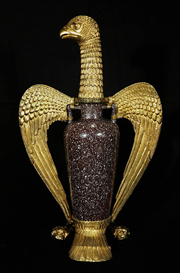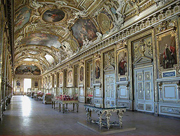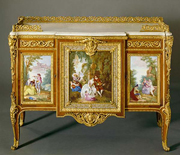|
|
 |
 |
 |
| The Department of Decorative Arts presents a highly varied range of objects, including jewelry, tapestries, ivories, bronzes, ceramics, and furniture. The collection extends from the Middle Ages to the first half of the 19th century. |
 |
 |
 |
 |
A Collection Steeped in History |
 |
 |


Porphyry vase "Suger's eagle"
© Musée du Louvre / E. Lessing
|
 |
 |
The decree issued by the Convention at the founding of the Muséum Central des Arts on July 27, 1793, stipulated that the exhibits would include objet’s d’art.
The nucleus of the collection was formed by furniture and objects from the former royal collection. Small bronzes and gems joined the collection a little later, in 1796.
The department was subsequently enriched by two important treasures, from the Sainte Chapelle on the nearby Ile de la Cité and the abbey of Saint-Denis to the north of Paris (including Abbot Suger's collection of vases and the coronation regalia of the kings of France).
The collections were further supplemented thanks to the decree of Germinal 1 year II (March 21, 1794) authorizing the museum to confiscate property belonging to émigré aristocrats who had fled abroad to escape the Revolution.
Revolutionary and imperial conquests or purchases, such as the shield and helmet of Charles IX, brought further riches.
In 1802, when Dominique-Vivant Denon was appointed director of the Muséum Central des Arts, the decorative arts collection was administered by the Department of Antiquities (under Ennio Quirino Visconti).
By 1818, when Visconti died and was succeeded by the comte de Clarac, the initial collection was somewhat diminished: sixteen objects from Saint-Denis were sold in 1798, Napoleon I requisitioned some items for his imperial palaces, and the year 1815 saw the restitution of works acquired as a result of the Napoleonic conquests. |
 |
 |
 |
 |
Great Expansion During the 19th Century |
 |
 |


Galerie d'Apollon
© Musée du Louvre / A. Dequier
|
 |
 |
Thanks to a very active acquisitions policy, under the Restoration the department acquired many new works, including the collections of the wealthy art lover Edme-Antoine Durand (1825) and the painter Pierre Révoil (1828). The department now incorporated a coherent group of medieval and Renaissance objects representing a wide range of techniques. The policy was not pursued under Louis-Philippe, although the treasure of the Ordre du Saint-Esprit was acquired in 1830.
The comte de Clarac died in 1847, and responsibility for the decorative arts collection (together with sculpture, and Greek and Roman antiquities) passed to the marquis de Laborde, whose tenure ended with his resignation in 1854. During the Second Empire, the collection was further extended by the creation of the short-lived Musée des Souverains, founded by Napoleon III (February 15, 1852) with the aim of consolidating his dynastic pretensions; the museum brought together works from Childeric to Louis-Philippe, drawn from the Louvre, the royal furniture repository, the Bibliothèque Nationale, and private donations. The curator was comte Horace de Viel-Castel, who was succeeded in 1863 by Henry Barbet de Jouy.
The Louvre subsequently acquired several important collections, including those of Sauvageot (1856) and Campana (1861). The Musée des Souverains was created in 1872, when the collections of sculpture and decorative arts were brought together once again under the direction of Barbet de Jouy and, later, Edmond Saglio. The decorative arts collection was finally granted separate departmental status in 1893.
|
 |
 |
 |
 |
Important Collections and Donations |
 |
| |


Martin CARLIN (attribué à ), Charles-Nicolas DODIN La Commode de Madame du Barry vers 1772
© R.M.N./D. Arnaudet |
 |
 |
After the fall of the empire in 1870, the Louvre acquired items from the Saint-Cloud and Tuileries palaces (destroyed by fire soon afterward). The collection was progressively enhanced by works from the 17th and 18th centuries, housed in a section opened by Emile Molinier. Up until 1965, contributions from the Mobilier National also entered the collection on a regular basis. The history of the Department of Decorative Arts in the late 19th and early 20th centuries is punctuated by important donations, such as the Adolphe Thiers collection (bequeathed by Madame Thiers in 1880).
In 1922, the bequest of baronne Salomon de Rothschild enriched the department with pieces from the Italian and French Renaissance, together with 18th-century works. The first donations of period-specific collections covered the Middle Ages and the Renaissance (the Davillier, Adolphe de Rothschild, and Arconati Visconti collections). Collections of 17th and 18th-century works (Isaac de Camondo, Basile de Schlichting) also arrived in the early 1900s.
This prestigious core was enriched by many further donations (M. and Mme David David-Weill, 1946; Stavros S. Niarchos, 1955; M. and Mme Grog-Carven, 1973). In 1981, the increasingly cramped display took over space vacated by the Ministry of Finance, and incorporated the Louvre's richly decorated Napoleon III Apartments. In 1993, new galleries were opened, devoted to the Middle Ages and the Renaissance. The 19th-century collection (greatly enriched in recent years) was presented to the public for the first time in 1999. |
 |
 |
 |
 |
New Galleries for the Louvre’s 18th Century Decorative Arts |
 |
| |
The 18th century decorative arts galleries located in the north wing of the Cour Carrée of the Louvre palace have not been modified since 1960 when they were installed by Pierre Verlet, chief curator of the department between 1945 and 1972. The galleries have been closed to the public since January 2005.
The collection has outgrown its current configuration which occupies 21,500 square feet of exhibition space. The goal of the renovation is to create the highest quality display for visitors while
respecting the need for the maximum security of the objects.
The presentation of the collections will be designed to allow visitors to appreciate the exhibits in the richest possible aesthetic and historic context. Particular emphasis will be placed on the composition of decorative ensembles, in order to create an immediate visual impact prior to the detailed observation of individual works.
The new galleries will enrich the visitor experience through educational and interpretive elements integrated into the displays and wall texts, and information and orientation support areas where members of the public can consult cultural and educational tools relating to the collections. |
|
 |